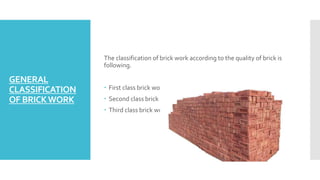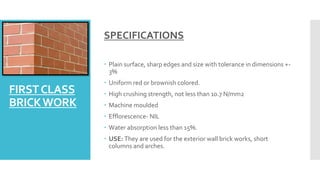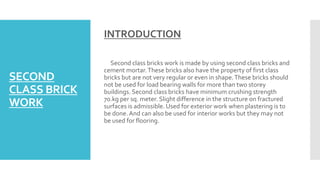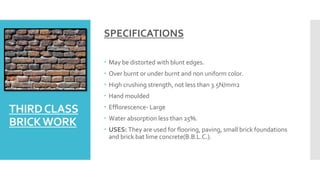Specification for different classes of Brickworks
Download as PPTX, PDF1 like3,720 views
This document classifies and specifies requirements for three classes of brickwork used in construction. First class brickwork uses high quality, uniformly shaped bricks with a crushing strength over 10.7N/mm2. It is used for load-bearing walls. Second class brickwork allows for slightly irregular bricks with strength over 7N/mm2 and is used for internal and compound walls. Third class brickwork consists of lower quality, non-uniform bricks with strength over 3.5N/mm2 and is used for temporary construction or flooring.
1 of 9
Downloaded 19 times









Recommended
specification of Rcc



specification of RccPrabhat chhirolya
╠²
The document discusses reinforced cement concrete (RCC), including its history, materials, specifications, and advantages/disadvantages. RCC uses steel reinforcement embedded in concrete to resist tensile, shear, and sometimes compressive stresses. Fran├¦ois Coignet is considered a pioneer of RCC, building the first reinforced concrete structure in 1853. Proper proportions and mixing of cement, aggregates like sand and gravel, and water are needed to produce durable concrete. Precast concrete involves casting pieces off-site then transporting them for assembly.PRECAST BUILDING SYSTEM



PRECAST BUILDING SYSTEMSagar Shah
╠²
The document discusses precast concrete buildings. It begins with an introduction to precast construction and its advantages over conventional construction. It then describes various precast elements like beams, columns, slabs, walls, and connections. It discusses construction methodology, design considerations, cost comparison to cast-in-situ, standards, and provides case studies of precast buildings in India and abroad.Shoring



ShoringHarikrishna M.S
╠²
Shoring is the construction of a temporary structure to support an unsafe or unstable structure. There are three main types of shoring: raking shores, flying shores, and dead shores. Raking shores use inclined members called rakers to provide lateral support to walls. Flying shores provide temporary support between party walls when an intermediate building is demolished. Dead shores provide vertical support to walls and structures when the lower part of a wall is removed, such as to add an opening.Building finishes



Building finisheskuntansourav
╠²
This document discusses various types of flooring and wall cladding materials used in construction. It provides information on exterior and interior insulation finishing systems, roofing materials, waterproofing treatments, damp proofing, and terminite proofing. It also describes different stone flooring options like Shahabad stone, Kota stone, and marble stone flooring. Additional flooring materials discussed include chequered tiles, glazed tiles, block paving, terrazzo tiles, and various types of floor finishes.Low cost building materials and construction techniques



Low cost building materials and construction techniquesYash Kotgirwar
╠²
This document discusses low cost building materials and construction techniques to reduce costs. It describes using natural materials like bamboo, compressed earth blocks, mud plaster and straw which are sustainable and have low embodied energy. Manufactured materials discussed include fly ash bricks and coal washery reject bricks. Construction techniques to reduce costs include rat trap bond, cob construction, wattle and daub, jack arch roofs and using jali brickwork. The document emphasizes using local, recycled and non-toxic materials to minimize costs while ensuring longevity and environmental friendliness of structures.Damp proofing



Damp proofingRimpi Baro
╠²
This document discusses causes, effects, and methods of preventing dampness in buildings. It outlines several precautions that should be taken such as proper site drainage and wall thickness. Common causes of dampness include rising moisture, rain penetration, and poor drainage. Effects include breeding mosquitoes and damage to building materials. Methods of damp proofing discussed are damp proof courses, waterproof surface treatments, integral treatments during construction, cavity walls, and cement grouting of cracks. Specific materials used for damp proof courses like bitumen and mastic asphalt are also outlined.Prefabrication construction



Prefabrication constructionDivya Vishnoi
╠²
This document discusses prefabrication in construction. Prefabrication involves assembling components of a structure in a factory then transporting them to the construction site. It has advantages like reduced cost, time, and waste and allows work during poor weather. Common prefabricated components include columns, beams, waffle floors/roofs which are cast and cured off-site then erected using cranes. While prefabrication offers benefits, it also has disadvantages like potential breakage during transport and need for specialized equipment and labor. The document concludes that partial prefabrication is well-suited for Indian conditions.Prefabrication in construction



Prefabrication in constructionShailja km
╠²
Prefabrication╠²is the practice of assembling components of a╠²structure╠²in a╠²factory╠²or other╠²manufacturing╠²site, and╠²transporting╠²them to the╠²construction╠²site where the structure is to be located.
SPECIFICATION AND ESTIMATION



SPECIFICATION AND ESTIMATIONAr Naveen Naveen
╠²
This document discusses various methods of construction cost estimation, including preliminary estimates, plinth area method, cubical contents method, unit base method, abstract estimates, detailed estimates, bottom up method, and square foot estimates. It also discusses factors that influence specification, rate analysis, and final estimates. Preliminary estimates provide early project costs but have low accuracy of 20-30%. Detailed estimates use quantities, rates, and specifications to determine costs more accurately. The bottom up method aggregates task estimates to determine total project costs.Bc open pre fabricated construction system



Bc open pre fabricated construction systemAnuj Singhal
╠²
The document discusses an open prefabricated construction system. Some key points:
- Prefabrication involves assembling building components in a factory and transporting them to the construction site. This speeds up construction time and lowers costs while ensuring quality.
- An open prefabricated system uses precast concrete or steel components like floors, walls, beams and columns assembled on-site. It can be partially or fully prefabricated.
- Examples of full prefabricated open systems include the Nakagin Capsule Tower in Tokyo, with prefabricated steel living capsules bolted to a central concrete core. Prefabrication allowed efficient off-site assembly and construction.Adobe construction



Adobe constructionPrashanth Dommeti
╠²
Adobe is a traditional building material made of sun-dried mud bricks composed of sand, clay, straw, and water. Adobe construction originated in 600 BC in South America and involves forming mud bricks of varying dimensions and using a mud plaster to hold them together in walls. Traditional adobe buildings are best suited to dry climates where adobe roofs made of logs and vigas can be used. While adobe construction has advantages like low costs and natural temperature regulation, it also has disadvantages like vulnerability to damage from water, wind, and earthquakes requiring regular maintenance.TYPE OF STEEL TRUSS



TYPE OF STEEL TRUSSBhavishyaPahwa1
╠²
Trusses are triangular frameworks that use members in axial compression and tension to support loads. They are commonly used for roofs, floors, and bridges to span long distances. The main types are Pratt, Warren, Fink, and North Light trusses. Pratt trusses have diagonal members that slant down toward the middle, while Warren trusses have alternating compression and tension diagonals. Fink and North Light trusses are typically used for shorter roof spans. Truss members can be made of structural steel with standard cross sections like boxes, rectangles, and HEA shapes.CLADDING REPORT.pdf



CLADDING REPORT.pdfMohammad Salman
╠²
Cladding is a material applied over another to provide weather protection or aesthetic appeal for buildings. It controls infiltration, observes vapor egress, and provides durable and aesthetically pleasing appearances. Cladding materials include timber, PVC, stone, glass, and ceramics for interiors and terra cotta, metal, fiber cement, and brick for exteriors. Cladding serves primary roles of weather protection and secondary roles of insulation, fire resistance, and ease of cleaning.R.C.C. STAIRS



R.C.C. STAIRSAbhishek Mewada
╠²
Reinforced concrete is well-suited for constructing stairs due to its fire resistance, durability, strength, and pleasing appearance. R.C.C. stairs can be designed in various forms including straight flights, inclined slabs with half landings, string beams, cranked slabs, cantilevers, and spirals. The type of stair adopted depends on the space and loading conditions. Common stair arrangements include single straight flights, inclined slabs spanning longitudinally, string beams with horizontal slab spanning, cranked slabs inducing bending and torsion stresses, cantilever stairs with central supporting walls, and spiral or helical stairs used in prestige buildings.Damp proofing ppt



Damp proofing pptGhulam Mehdi Sahito
╠²
This document discusses various methods of damp-proofing and waterproofing buildings. It defines damp-proofing as preventing moisture from rising through walls, floors, and basements, while waterproofing refers to preventing water leakage from roofs. Common sources of dampness include rising ground moisture, rain splashing, and poor drainage. Dampness can cause issues like efflorescence, plaster damage, and mold growth. Methods of damp-proofing discussed include membrane barriers like bitumen and plastic sheets, integral waterproof concrete additives, and surface treatments to fill pores. Flexible, semi-rigid and rigid damp proof course materials are also outlined.Prefabrication



PrefabricationKush Agarwal
╠²
In these slides, prefabrication types and methods are integrated through easy language and diagrams.....
Stairs



StairsMitali V. Gondaliya
╠²
Stairs are designed to provide access between different levels of a building. The document defines stairs and their key components like treads, risers, landings, etc. It discusses different types of stairs like straight, turning, circular and geometrical. The materials used for stairs construction are also explained, including stone, timber, RCC, brick and metal stairs. Technical terms related to stairs are defined. In the end, common stair types are identified from images.Partition walls



Partition wallsHarpreet Oberoi
╠²
The document discusses different types of partition walls used to divide interior spaces in buildings. It describes timber stud, metal stud, drywall, glass block, and block partitions. Timber stud partitions can be plaster skimmed, dry-lined, or partially glazed. Metal stud partitions are lightweight but strong, consisting of a metal framework covered in plasterboard or fire-resistant sheeting. Glass block partitions are made of translucent glass blocks laid in mortar, sometimes with reinforcement. Block partitions are constructed from masonry blocks.Timber floor



Timber floorAmruta Khairnar
╠²
This document discusses different types of timber flooring, including:
1. Single joist timber floors which use a single beam and strutting for spans below 3 meters.
2. Double joist timber floors which use binders and bridging joists for spans between 1.8-2.4 meters.
3. Framed or triple joist timber floors which use girders, binders, and bridging joists for spans over 7.5 meters.
Precautions for timber flooring include using a cement course below the floor, installing DPC on exterior walls and sleeper walls, and using well-seasoned timber. Floor boards are typically 100-200mm wideGUNITING



GUNITINGARYAN GUPTA
╠²
Guniting is a process that uses a cement-sand mixture projected at high pressure through a cement gun to repair damaged concrete surfaces. The mixture, usually in a 1:3 cement to sand ratio, is deposited on the surface under 20-30 N/cm^2 of pressure. Guniting can be used on vertical, overhead, and horizontal surfaces to restore concrete damaged by corrosion or inferior work. It provides an impervious layer and high compressive strength of 56-70 N/mm^2.False ceiling



False ceilingAbhishek kumar maurya
╠²
This document provides an overview of false ceilings, including their introduction, purposes, types, materials, and installation. It discusses how false ceilings can improve aesthetics, hide ducting and wires, provide insulation and acoustic improvements. The types of false ceilings covered include suspended/exposed grid, concealed grid, metal, gypsum board, fiberboard, POP, and plywood. Installation photos of concealed and exposed grid ceilings are also presented. Rates and common material suppliers are listed.Basement construction report



Basement construction reportANKITAARORA85
╠²
The document provides information on basement construction, including:
1) Basements are constructed below ground level to provide additional space, act as a buoyancy raft, or reduce bearing pressure. They require retaining walls to withstand soil and water pressures.
2) There are different methods for basement construction including open cut, cut and cover, and top down. The cut and cover method uses retaining walls and bracing during excavation before basement construction.
3) Key considerations for basement design and construction include ventilation, drainage, waterproofing, and following local building codes.Precast construction



Precast constructionDivya Vishnoi
╠²
This presentation include the precast construction, precast components , advantages and disadvantages, their connections. curtain wall -skin of building



curtain wall -skin of buildingabidha karthu
╠²
The document discusses curtain wall systems. It begins with an introduction defining a curtain wall system as a non-structural outer covering that keeps weather and occupants in/out. The history notes that curtain walls emerged as exterior walls became non-load bearing. It describes the components of curtain walls including mullions, transoms, glass, and other materials. Functions are listed as protecting interiors from the environment while providing lighting and occupant comfort. The document also covers installation systems, loads, maintenance, and provides case studies of curtain wall implementations.Types of bricks and its bonds



Types of bricks and its bondsGiri Guru
╠²
This document discusses different types of bricks and brick bonding techniques. It describes common burnt clay bricks, sand lime bricks, fly ash bricks, AAC bricks, hollow bricks, and bio bricks. Each brick type has different properties like strength, weight, insulation, and environmental impact. The document also examines various brick bonds like stretcher bond, header bond, Flemish bond, English bond, and their structural applications in walls. Different bonding patterns help distribute loads and provide stability in masonry construction.Waterproofing and insulaton



Waterproofing and insulatonHamzah Meraj, Faculty of Architecture, Jamia Millia Islamia, New delhi
╠²
Waterproofing is used to prevent water from entering or escaping building structures. There are internal and external waterproofing membranes. Basement waterproofing is especially important to prevent hydrostatic pressure from causing moisture issues. Common types of basement waterproofing include sealants and water drainage systems. Sealants can be exterior or interior and come in different forms like films, paints or injected solutions. Water drainage systems use perimeter drains, pipes, and sump pumps to collect and remove groundwater from the basement. Proper waterproofing requires both sealing and drainage for effective below-ground protection.Plastering



PlasteringRoopa Chikkalgi
╠²
Plastering involves applying plaster, a mixture of lime or gypsum, sand, and water, to rough or uneven surfaces to make them smooth. The objectives of plastering are to provide an even, durable finished surface and protect the underlying structure. Several tools are used in plastering including trowels, floats, and hawks. There are different types of plaster like lime, cement, mud, and stucco plaster. Cement plaster is suited for damp conditions while lime plaster uses lime as the binding agent. Issues that can arise with plaster include cracking, efflorescence, plaster falling out, and blowing.Stone Masonry BUILDING CONSTRUCTION



Stone Masonry BUILDING CONSTRUCTIONRavindra Patnayaka
╠²
Stone masonry uses stones bonded together with mortar to construct various building components such as walls, columns, foundations, arches and lintels. Stones are selected based on availability, ease of working, appearance, strength, polishing characteristics and economy. There are two main types of stone masonry - rubble masonry which uses roughly dressed stones with wider joints, and ashlar masonry which uses accurately dressed stones with fine, uniform joints. Rubble masonry includes uncoursed, coursed, random, dry and polygonal styles based on stone arrangement. Ashlar masonry has fine, rough, rock-faced, block and chamfered styles based on stone dressing. StoneBrick masonary



Brick masonaryRakesh Verma
╠²
Brick work covered under building material, is very essential par of construction work in Civil Engineering. brickmasonry-230211140056-e3a1df36.pdf



brickmasonry-230211140056-e3a1df36.pdfKrupalks
╠²
Brick masonry provides fire resistance, durability, and strength due to its homogeneous mass when bricks are laid in mortar. There are different types of bonds that provide varying strength, with English bond being the strongest. Bricks must meet quality standards like being uniformly shaped, emitting a clear ringing sound when struck, and having low water absorption. Proper tools and techniques are used to lay bricks in bonds with headers, stretchers, and closures to reinforce the wall structure. Brick masonry walls can be constructed using various bonds and have advantages of low cost and availability of materials.More Related Content
What's hot (20)
SPECIFICATION AND ESTIMATION



SPECIFICATION AND ESTIMATIONAr Naveen Naveen
╠²
This document discusses various methods of construction cost estimation, including preliminary estimates, plinth area method, cubical contents method, unit base method, abstract estimates, detailed estimates, bottom up method, and square foot estimates. It also discusses factors that influence specification, rate analysis, and final estimates. Preliminary estimates provide early project costs but have low accuracy of 20-30%. Detailed estimates use quantities, rates, and specifications to determine costs more accurately. The bottom up method aggregates task estimates to determine total project costs.Bc open pre fabricated construction system



Bc open pre fabricated construction systemAnuj Singhal
╠²
The document discusses an open prefabricated construction system. Some key points:
- Prefabrication involves assembling building components in a factory and transporting them to the construction site. This speeds up construction time and lowers costs while ensuring quality.
- An open prefabricated system uses precast concrete or steel components like floors, walls, beams and columns assembled on-site. It can be partially or fully prefabricated.
- Examples of full prefabricated open systems include the Nakagin Capsule Tower in Tokyo, with prefabricated steel living capsules bolted to a central concrete core. Prefabrication allowed efficient off-site assembly and construction.Adobe construction



Adobe constructionPrashanth Dommeti
╠²
Adobe is a traditional building material made of sun-dried mud bricks composed of sand, clay, straw, and water. Adobe construction originated in 600 BC in South America and involves forming mud bricks of varying dimensions and using a mud plaster to hold them together in walls. Traditional adobe buildings are best suited to dry climates where adobe roofs made of logs and vigas can be used. While adobe construction has advantages like low costs and natural temperature regulation, it also has disadvantages like vulnerability to damage from water, wind, and earthquakes requiring regular maintenance.TYPE OF STEEL TRUSS



TYPE OF STEEL TRUSSBhavishyaPahwa1
╠²
Trusses are triangular frameworks that use members in axial compression and tension to support loads. They are commonly used for roofs, floors, and bridges to span long distances. The main types are Pratt, Warren, Fink, and North Light trusses. Pratt trusses have diagonal members that slant down toward the middle, while Warren trusses have alternating compression and tension diagonals. Fink and North Light trusses are typically used for shorter roof spans. Truss members can be made of structural steel with standard cross sections like boxes, rectangles, and HEA shapes.CLADDING REPORT.pdf



CLADDING REPORT.pdfMohammad Salman
╠²
Cladding is a material applied over another to provide weather protection or aesthetic appeal for buildings. It controls infiltration, observes vapor egress, and provides durable and aesthetically pleasing appearances. Cladding materials include timber, PVC, stone, glass, and ceramics for interiors and terra cotta, metal, fiber cement, and brick for exteriors. Cladding serves primary roles of weather protection and secondary roles of insulation, fire resistance, and ease of cleaning.R.C.C. STAIRS



R.C.C. STAIRSAbhishek Mewada
╠²
Reinforced concrete is well-suited for constructing stairs due to its fire resistance, durability, strength, and pleasing appearance. R.C.C. stairs can be designed in various forms including straight flights, inclined slabs with half landings, string beams, cranked slabs, cantilevers, and spirals. The type of stair adopted depends on the space and loading conditions. Common stair arrangements include single straight flights, inclined slabs spanning longitudinally, string beams with horizontal slab spanning, cranked slabs inducing bending and torsion stresses, cantilever stairs with central supporting walls, and spiral or helical stairs used in prestige buildings.Damp proofing ppt



Damp proofing pptGhulam Mehdi Sahito
╠²
This document discusses various methods of damp-proofing and waterproofing buildings. It defines damp-proofing as preventing moisture from rising through walls, floors, and basements, while waterproofing refers to preventing water leakage from roofs. Common sources of dampness include rising ground moisture, rain splashing, and poor drainage. Dampness can cause issues like efflorescence, plaster damage, and mold growth. Methods of damp-proofing discussed include membrane barriers like bitumen and plastic sheets, integral waterproof concrete additives, and surface treatments to fill pores. Flexible, semi-rigid and rigid damp proof course materials are also outlined.Prefabrication



PrefabricationKush Agarwal
╠²
In these slides, prefabrication types and methods are integrated through easy language and diagrams.....
Stairs



StairsMitali V. Gondaliya
╠²
Stairs are designed to provide access between different levels of a building. The document defines stairs and their key components like treads, risers, landings, etc. It discusses different types of stairs like straight, turning, circular and geometrical. The materials used for stairs construction are also explained, including stone, timber, RCC, brick and metal stairs. Technical terms related to stairs are defined. In the end, common stair types are identified from images.Partition walls



Partition wallsHarpreet Oberoi
╠²
The document discusses different types of partition walls used to divide interior spaces in buildings. It describes timber stud, metal stud, drywall, glass block, and block partitions. Timber stud partitions can be plaster skimmed, dry-lined, or partially glazed. Metal stud partitions are lightweight but strong, consisting of a metal framework covered in plasterboard or fire-resistant sheeting. Glass block partitions are made of translucent glass blocks laid in mortar, sometimes with reinforcement. Block partitions are constructed from masonry blocks.Timber floor



Timber floorAmruta Khairnar
╠²
This document discusses different types of timber flooring, including:
1. Single joist timber floors which use a single beam and strutting for spans below 3 meters.
2. Double joist timber floors which use binders and bridging joists for spans between 1.8-2.4 meters.
3. Framed or triple joist timber floors which use girders, binders, and bridging joists for spans over 7.5 meters.
Precautions for timber flooring include using a cement course below the floor, installing DPC on exterior walls and sleeper walls, and using well-seasoned timber. Floor boards are typically 100-200mm wideGUNITING



GUNITINGARYAN GUPTA
╠²
Guniting is a process that uses a cement-sand mixture projected at high pressure through a cement gun to repair damaged concrete surfaces. The mixture, usually in a 1:3 cement to sand ratio, is deposited on the surface under 20-30 N/cm^2 of pressure. Guniting can be used on vertical, overhead, and horizontal surfaces to restore concrete damaged by corrosion or inferior work. It provides an impervious layer and high compressive strength of 56-70 N/mm^2.False ceiling



False ceilingAbhishek kumar maurya
╠²
This document provides an overview of false ceilings, including their introduction, purposes, types, materials, and installation. It discusses how false ceilings can improve aesthetics, hide ducting and wires, provide insulation and acoustic improvements. The types of false ceilings covered include suspended/exposed grid, concealed grid, metal, gypsum board, fiberboard, POP, and plywood. Installation photos of concealed and exposed grid ceilings are also presented. Rates and common material suppliers are listed.Basement construction report



Basement construction reportANKITAARORA85
╠²
The document provides information on basement construction, including:
1) Basements are constructed below ground level to provide additional space, act as a buoyancy raft, or reduce bearing pressure. They require retaining walls to withstand soil and water pressures.
2) There are different methods for basement construction including open cut, cut and cover, and top down. The cut and cover method uses retaining walls and bracing during excavation before basement construction.
3) Key considerations for basement design and construction include ventilation, drainage, waterproofing, and following local building codes.Precast construction



Precast constructionDivya Vishnoi
╠²
This presentation include the precast construction, precast components , advantages and disadvantages, their connections. curtain wall -skin of building



curtain wall -skin of buildingabidha karthu
╠²
The document discusses curtain wall systems. It begins with an introduction defining a curtain wall system as a non-structural outer covering that keeps weather and occupants in/out. The history notes that curtain walls emerged as exterior walls became non-load bearing. It describes the components of curtain walls including mullions, transoms, glass, and other materials. Functions are listed as protecting interiors from the environment while providing lighting and occupant comfort. The document also covers installation systems, loads, maintenance, and provides case studies of curtain wall implementations.Types of bricks and its bonds



Types of bricks and its bondsGiri Guru
╠²
This document discusses different types of bricks and brick bonding techniques. It describes common burnt clay bricks, sand lime bricks, fly ash bricks, AAC bricks, hollow bricks, and bio bricks. Each brick type has different properties like strength, weight, insulation, and environmental impact. The document also examines various brick bonds like stretcher bond, header bond, Flemish bond, English bond, and their structural applications in walls. Different bonding patterns help distribute loads and provide stability in masonry construction.Waterproofing and insulaton



Waterproofing and insulatonHamzah Meraj, Faculty of Architecture, Jamia Millia Islamia, New delhi
╠²
Waterproofing is used to prevent water from entering or escaping building structures. There are internal and external waterproofing membranes. Basement waterproofing is especially important to prevent hydrostatic pressure from causing moisture issues. Common types of basement waterproofing include sealants and water drainage systems. Sealants can be exterior or interior and come in different forms like films, paints or injected solutions. Water drainage systems use perimeter drains, pipes, and sump pumps to collect and remove groundwater from the basement. Proper waterproofing requires both sealing and drainage for effective below-ground protection.Plastering



PlasteringRoopa Chikkalgi
╠²
Plastering involves applying plaster, a mixture of lime or gypsum, sand, and water, to rough or uneven surfaces to make them smooth. The objectives of plastering are to provide an even, durable finished surface and protect the underlying structure. Several tools are used in plastering including trowels, floats, and hawks. There are different types of plaster like lime, cement, mud, and stucco plaster. Cement plaster is suited for damp conditions while lime plaster uses lime as the binding agent. Issues that can arise with plaster include cracking, efflorescence, plaster falling out, and blowing.Stone Masonry BUILDING CONSTRUCTION



Stone Masonry BUILDING CONSTRUCTIONRavindra Patnayaka
╠²
Stone masonry uses stones bonded together with mortar to construct various building components such as walls, columns, foundations, arches and lintels. Stones are selected based on availability, ease of working, appearance, strength, polishing characteristics and economy. There are two main types of stone masonry - rubble masonry which uses roughly dressed stones with wider joints, and ashlar masonry which uses accurately dressed stones with fine, uniform joints. Rubble masonry includes uncoursed, coursed, random, dry and polygonal styles based on stone arrangement. Ashlar masonry has fine, rough, rock-faced, block and chamfered styles based on stone dressing. StoneSimilar to Specification for different classes of Brickworks (20)
Brick masonary



Brick masonaryRakesh Verma
╠²
Brick work covered under building material, is very essential par of construction work in Civil Engineering. brickmasonry-230211140056-e3a1df36.pdf



brickmasonry-230211140056-e3a1df36.pdfKrupalks
╠²
Brick masonry provides fire resistance, durability, and strength due to its homogeneous mass when bricks are laid in mortar. There are different types of bonds that provide varying strength, with English bond being the strongest. Bricks must meet quality standards like being uniformly shaped, emitting a clear ringing sound when struck, and having low water absorption. Proper tools and techniques are used to lay bricks in bonds with headers, stretchers, and closures to reinforce the wall structure. Brick masonry walls can be constructed using various bonds and have advantages of low cost and availability of materials.BRICK MASONRY.pptx



BRICK MASONRY.pptxErankajKumar
╠²
BRICK MASONRY INRODUCTION
BRICK MASONRY-UNIQUENESS
CHARACTERISTIC OF BRICKS
ADVANTAGE OF BRICK MASONRY
MANUFACTURE OF BRICKS
TYPES OF BRICKS USED IN MASONARY WORK
TYPES OF BRICK MASONRY BOND
ENGLISH BOND
FLEMISH BOND
HEADER BOND
STRETCHER BOND
TYPES OF BRICKS MASONARY
TOOLS USED IN BRICK MASONRY
BRICKS COURSES & CLOSURES
RULES FOR GOOD BRICKS BONDING
QUALITIES OF GOOD BRICKS
CLASSIFICATION OF BRICKS
TEST FOR BRICKS
DEFECTS IN BRICK MASONRY
CONCLUSION
Materials & Methods of Construction - CE145



Materials & Methods of Construction - CE145Saqib Imran
╠²
This document provides a detailed classification of different types of bricks based on various factors such as quality, manufacturing process, raw materials, intended use, weather resistance, and shape. It identifies several classes of bricks including first, second, and third class bricks based on quality standards. It also discusses different types of bricks such as burnt clay bricks, fly ash clay bricks, concrete bricks, sand-lime bricks, and firebricks which vary according to their raw material composition. Bricks are further classified based on factors like intended location of use, weather resistance requirements, and special shapes required for applications like rounded edges, air circulation, drainage, and wall capping.Brick seminar



Brick seminarKaustubhDharDwivedi
╠²
This document summarizes information about bricks, including their composition, types, manufacturing process, quality standards, and uses. Bricks are made from clay and are a common building material used worldwide in structures. The document outlines the various classes of bricks based on their quality and burning, and describes how bricks are manufactured through processes of clay preparation, molding, drying, and burning. It also discusses tests conducted on bricks to assess properties like absorption, strength, and size. Bricks have many applications in construction as basic building blocks for walls, floors, and other structural elements.Bricks 



Bricks Durga Devi Sharma
╠²
1. Bricks are made from clay and are one of the oldest and most widely used building materials. They are inexpensive, durable, and easy to work with.
2. The document discusses the manufacturing process of bricks including preparing the brick earth by blending clay with additives, molding, drying, and burning the bricks.
3. Bricks are classified based on their quality, strength, size, method of manufacture, and degree of burning. Special types of bricks include perforated, hollow, circular, and paving bricks used for specific construction purposes.Stones, Bricks & Tiles.pptx



Stones, Bricks & Tiles.pptxShaik Nurulla
╠²
This Presentation focuses on Stones, Bricks and Tiles which is under the category of Civil Engineering Materials.Bricks



BricksDigvijaysinh Gohil
╠²
This document provides an introduction and overview of bricks, including their composition, types, properties, and uses. It discusses the main ingredients that make up clay bricks, such as alumina, silica, lime, and iron oxide. Bricks are classified based on their quality after burning, with first class bricks being the hardest and used for important structures. Other types discussed include hollow bricks, fly-ash bricks, refractory bricks, and perforated bricks. The properties of good burnt clay bricks are that they are uniformly burnt and hard with high compressive strength.Brick



Brickkajal018
╠²
About Brick - definition, manufacturing process, classification, types and Brick Masonry - terminology, types of bonds. ( Stretcher, Header, English and Flemish)Bricks



BricksJitesh Dhule
╠²
This document defines bricks and their constituents and manufacturing process. It provides the following key details:
- Bricks are clay constructions of uniform size and shape, traditionally 23cm x 11.4cm x 7.6cm or modular 19cm x 9cm x 9cm.
- Good bricks contain 50-60% silica, 20-30% alumina, up to 5% lime, and 5-6% iron oxide.
- Bricks are manufactured through processes of preparation, molding, drying for 7-14 days, and burning at 750-1000┬░C using clamp or kiln methods.
- Various bonds including English, Flemish, stretcher and header are used in brickwork constructionbricks.pdf



bricks.pdfreshma804542
╠²
This document defines bricks and their constituents and manufacturing process. It provides the following key details:
- Bricks are clay constructions of uniform size and shape, traditionally 23cm x 11.4cm x 7.6cm or modular 19cm x 9cm x 9cm.
- Good bricks contain 50-60% silica, 20-30% alumina, up to 5% lime, and 5-6% iron oxide.
- Bricks are manufactured through processes of preparation, molding, drying for 7-14 days, and burning at 750-1000┬░C using clamp or kiln methods.
- Various bonds including English, Flemish, stretcher and header are used in brickwork constructionCOMPRESSIVE & CRUSHING STRENGTH OF BRICK'S.pptx



COMPRESSIVE & CRUSHING STRENGTH OF BRICK'S.pptxMOHDTARIQFAROOQUI
╠²
This document discusses the properties and classification of bricks. It defines bricks as being regularly shaped objects that are convenient to handle. Bricks can be made of clay, sand and lime, or concrete. Standard brick sizes are listed. Good brick earth contains clay, sand, lime and iron oxide. Bricks are classified into four classes based on their quality. First class bricks are best for permanent structures. Second class have minor cracks but are also suitable for plastered buildings. Third class have rough surfaces and are for unimportant temporary structures. Fourth class are overburnt for uses like aggregates. Bricks are widely used in construction for buildings, roads, and more.classfication of Bricks by Dhurba.pptx



classfication of Bricks by Dhurba.pptxDhurbaBhatt
╠²
Bricks are classified as either sun dried/katcha bricks or burnt/pacca bricks. Sun dried bricks are made through natural drying and used for temporary structures due to lack of durability when wet. Burnt bricks are fired, making them hard, strong, and durable for permanent construction. Burnt bricks are further classified into four classes based on their quality - first class bricks are well-burnt without cracks while overburnt/jhama bricks are misshapen and used for aggregates. A variety of tests are used to determine brick suitability for construction purposes.BRICK MASONRY



BRICK MASONRYSUDIP KUMAR HOR
╠²
Brick masonry involves laying bricks together using mortar. Bricks are laid in various bond patterns with headers and stretchers. English bond and Flemish bond are common, strong bonds. Brick masonry walls are durable and fire resistant due to the thermal mass of bricks. Proper bonding, jointing, and avoiding continuous vertical joints are important for strength. Bricks are classified based on quality and used for different purposes depending on loads and importance of structure.Bricks



Brickssangeen khan khan
╠²
The document discusses different types of bricks used in construction. It describes the manufacturing process which involves preparing clay, moulding, drying, and burning bricks either in clamps or kilns. Bricks are categorized as burnt or unburnt, with burnt bricks further divided into four classes based on their quality. The document provides details on the water absorption rates and compressive strengths of different brick classes. It also outlines qualities of good bricks and lists some major brick manufacturing plants in Pakistan.Bricks



BricksPiyushThakre3
╠²
Bricks are building materials used in masonry construction that are traditionally composed of clay but can also be made of concrete or other materials. They are produced in bulk quantities in various classes, types, sizes, and materials depending on region and time period. Bricks have been used throughout history by many ancient civilizations as one of the first building materials and continue to be widely used today due to their durability, compressive strength, and fire resistance.BRICK MASONRY PPT BY SUBHENDU SAMUI



BRICK MASONRY PPT BY SUBHENDU SAMUISubhendu Samui
╠²
Brick masonry involves laying bricks together with mortar to form walls or structures. There are different brick bonds like English, Flemish, and header bonds that are used. Bricks are available in various sizes and classes depending on their quality. Masonry tools and proper techniques are needed to lay bricks correctly. Tests are done to ensure brick quality and defects can occur if bricks absorb too much water or have soluble salts. Overall, brick masonry is a durable and fire resistant building method.ppt by subhendu samui



ppt by subhendu samuiSubhendu Samui
╠²
Brick masonry involves laying bricks together with mortar to form walls or structures. There are different brick bonds like English, Flemish, and header bonds that are used. Bricks are manufactured through a process of mixing raw materials like fly ash, lime, and sand, and then pressing and curing the bricks. Brick masonry has advantages like fire resistance, durability, and economy. Proper tools, techniques, and testing help ensure high quality brick masonry.Recently uploaded (20)
AI and Academic Writing, Short Term Course in Academic Writing and Publicatio...



AI and Academic Writing, Short Term Course in Academic Writing and Publicatio...Prof. (Dr.) Vinod Kumar Kanvaria
╠²
AI and Academic Writing, Short Term Course in Academic Writing and Publication, UGC-MMTTC, MANUU, 25/02/2025, Prof. (Dr.) Vinod Kumar Kanvaria, University of Delhi, vinodpr111@gmail.comAdministrative bodies( D and C Act, 1940



Administrative bodies( D and C Act, 1940P.N.DESHMUKH
╠²
These presentation include information about administrative bodies such as D.T.A.B
CDL AND DCC, etc.NUTRITIONAL ASSESSMENT AND EDUCATION - 5TH SEM.pdf



NUTRITIONAL ASSESSMENT AND EDUCATION - 5TH SEM.pdfDolisha Warbi
╠²
NUTRITIONAL ASSESSMENT AND EDUCATION, Introduction, definition, types - macronutrient and micronutrient, food pyramid, meal planning, nutritional assessment of individual, family and community by using appropriate method, nutrition education, nutritional rehabilitation, nutritional deficiency disorder, law/policies regarding nutrition in India, food hygiene, food fortification, food handling and storage, food preservation, food preparation, food purchase, food consumption, food borne diseases, food poisoningRRB ALP CBT 2 RAC Question Paper MCQ (Railway Assistant Loco Pilot)



RRB ALP CBT 2 RAC Question Paper MCQ (Railway Assistant Loco Pilot)SONU HEETSON
╠²
RRB ALP CBT 2 RAC Question Paper MCQ PDF Free Download. Railway Assistant Loco Pilot Mechanic Refrigeration and Air Conditioning Important Questions.Intellectual Honesty & Research Integrity.pptx



Intellectual Honesty & Research Integrity.pptxNidhiSharma495177
╠²
Research Publication & Ethics contains a chapter on Intellectual Honesty and Research Integrity.
Different case studies of intellectual dishonesty and integrity were discussed.Entity Framework Interview Questions PDF By ScholarHat



Entity Framework Interview Questions PDF By ScholarHatScholarhat
╠²
Entity Framework Interview Questions PDF By ScholarHatMeeting the needs of modern students?, Selina McCoy



Meeting the needs of modern students?, Selina McCoyEconomic and Social Research Institute
╠²
NAPD Annual Symposium
ŌĆ£Equity in our Schools: Does the system deliver for all young people?ŌĆØOral exam Kenneth Bech - What is the meaning of strategic fit?



Oral exam Kenneth Bech - What is the meaning of strategic fit?MIPLM
╠²
Presentation of the CEIPI DU IPBA oral exam of Kenneth Bech - What is the meaning of strategic fit? Odoo 18 Accounting Access Rights - Odoo 18 ║▌║▌▀Żs



Odoo 18 Accounting Access Rights - Odoo 18 ║▌║▌▀ŻsCeline George
╠²
In this slide, weŌĆÖll discuss on accounting access rights in odoo 18. To ensure data security and maintain confidentiality, Odoo provides a robust access rights system that allows administrators to control who can access and modify accounting data. Azure Data Engineer Interview Questions By ScholarHat



Azure Data Engineer Interview Questions By ScholarHatScholarhat
╠²
Azure Data Engineer Interview Questions By ScholarHatBß╗ś TEST KIß╗éM TRA GIß╗«A K├ī 2 - TIß║ŠNG ANH 10,11,12 - CHUß║©N FORM 2025 - GLOBAL SU...



Bß╗ś TEST KIß╗éM TRA GIß╗«A K├ī 2 - TIß║ŠNG ANH 10,11,12 - CHUß║©N FORM 2025 - GLOBAL SU...Nguyen Thanh Tu Collection
╠²
https://app.box.com/s/ij1ty3vm7el9i4qfrr41o756xycbahmgYear 10 The Senior Phase Session 3 Term 1.pptx



Year 10 The Senior Phase Session 3 Term 1.pptxmansk2
╠²
Year 10 The Senior Phase Session 3 Term 1.pptxEffective Product Variant Management in Odoo 18



Effective Product Variant Management in Odoo 18Celine George
╠²
In this slide weŌĆÖll discuss on the effective product variant management in Odoo 18. Odoo concentrates on managing product variations and offers a distinct area for doing so. Product variants provide unique characteristics like size and color to single products, which can be managed at the product template level for all attributes and variants or at the variant level for individual variants.AI and Academic Writing, Short Term Course in Academic Writing and Publicatio...



AI and Academic Writing, Short Term Course in Academic Writing and Publicatio...Prof. (Dr.) Vinod Kumar Kanvaria
╠²
Bß╗ś TEST KIß╗éM TRA GIß╗«A K├ī 2 - TIß║ŠNG ANH 10,11,12 - CHUß║©N FORM 2025 - GLOBAL SU...



Bß╗ś TEST KIß╗éM TRA GIß╗«A K├ī 2 - TIß║ŠNG ANH 10,11,12 - CHUß║©N FORM 2025 - GLOBAL SU...Nguyen Thanh Tu Collection
╠²
Specification for different classes of Brickworks
- 1. SPECIFICATIONAND CONTROL SPECIFICATION FOR 1ST, 2ND AND 3RD CLASS BRICKWORK PRESENTED BY ŌĆōVIGHNESH B RANE
- 2. INTRODUCTION Bricks may be defined as ŌĆØ Structural units of rectangular shape and convenient size that are made from a suitable type of clays by molding, drying and burning.ŌĆØ Brick work are probably the most common building elements in construction of a house in India. These walls form basic units for creating rooms that make up a house. The walls besides being space dividers are also structural elements that transfer the load of the roof to the ground. Brick walls are constructed on strip spread or raft foundations that support the walls. The walls are constructed using bricks and mortar. These can also be constructed with various structural qualities and thicknesses. Brick walls are constructed by joining bricks with cement mortar in arrangements called English Bond, Flemish Bond or Rat Trap Bond. These bonds give different external appearances to the wall. All construction systems of brick walls are such devised that vertical cross joints in any layers are staggered. The bricks thus bonded form a solid mass that does not split when the wall is loaded with live loads and dead loads.
- 3. GENERAL CLASSIFICATION OF BRICKWORK The classification of brick work according to the quality of brick is following. ’é¢ First class brick work ’é¢ Second class brick work ’é¢ Third class brick work
- 4. FIRSTCLASS BRICKWORK INTRODUCTION First class brick work is made by using first class bricks and cement mortar.This brick work is used for load bearing walls. It is made in rich mortar in which the cement and sand ratio is from 1:3 to 1: 6. First class bricks are identified by their uniform color and a ringing sound when struck.The bricks are equal in size and have even edges and surfaces.These bricks do not chip and donŌĆÖt have any cracks. First class bricks do not absorb water more than 1/6 of their weight. There is no salty residue when the bricks are dry. First class bricks have a minimum crushing strength of 105.kg. Per sq. cm
- 5. FIRSTCLASS BRICKWORK SPECIFICATIONS ’é¢ Plain surface, sharp edges and size with tolerance in dimensions +- 3% ’é¢ Uniform red or brownish colored. ’é¢ High crushing strength, not less than 10.7 N/mm2 ’é¢ Machine moulded ’é¢ Efflorescence- NIL ’é¢ Water absorption less than 15%. ’é¢ USE: They are used for the exterior wall brick works, short columns and arches.
- 6. SECOND CLASS BRICK WORK INTRODUCTION Second class bricks work is made by using second class bricks and cement mortar.These bricks also have the property of first class bricks but are not very regular or even in shape.These bricks should not be used for load bearing walls for more than two storey buildings. Second class bricks have minimum crushing strength 70.kg per sq. meter. Slight difference in the structure on fractured surfaces is admissible. Used for exterior work when plastering is to be done. And can also be used for interior works but they may not be used for flooring.
- 7. SECOND CLASS BRICK WORK SPECIFICATIONS ’é¢ Slightly uneven faces and edges with tolerance in dimensions +- 8% ’é¢ Uniform colored but may be slightly over burnt. ’é¢ High crushing strength, not less than 7 N/mm2 ’é¢ Hand moulded ’é¢ Efflorescence- Little ’é¢ Water absorption less than 20%. ’é¢ USE: They are used for internal walls and compound walls.
- 8. THIRDCLASS BRICKWORK INTRODUCTION ’é¢ This type of brick work is made by using third class bricks and cement mortar or mud mortar.Third class brick work is not made in any Govt. work. Generally this type of brick work is made for temporary work in private sector.These are not burnt so fully as in previous two cases but are generally of uniform reddish yellow color. Defects in uniformity or shape are tolerated. On striking together, they produce a dull thud sound. Its compressive strength lies between 35 ŌĆō 70 kg/cm2 and absorption between 22 ŌĆō 25 percent.They are used mostly in the ordinary type of construction and in dry situations.
- 9. THIRDCLASS BRICKWORK SPECIFICATIONS ’é¢ May be distorted with blunt edges. ’é¢ Over burnt or under burnt and non uniform color. ’é¢ High crushing strength, not less than 3.5N/mm2 ’é¢ Hand moulded ’é¢ Efflorescence- Large ’é¢ Water absorption less than 25%. ’é¢ USES: They are used for flooring, paving, small brick foundations and brick bat lime concrete(B.B.L.C.).








